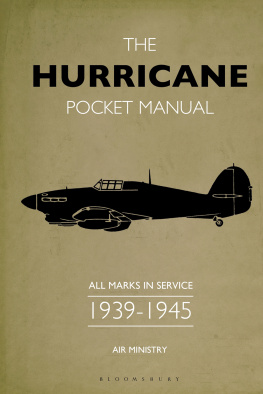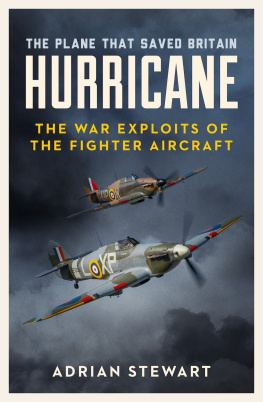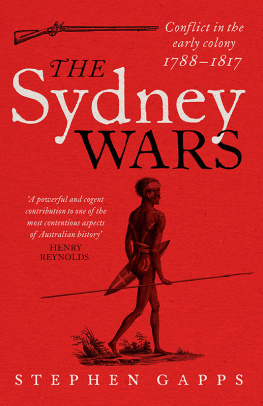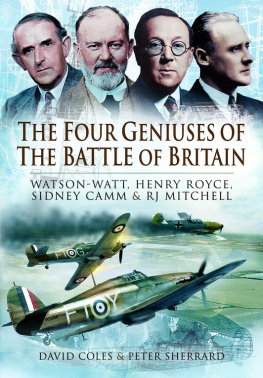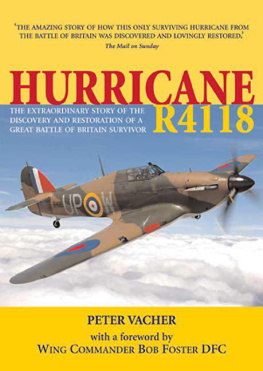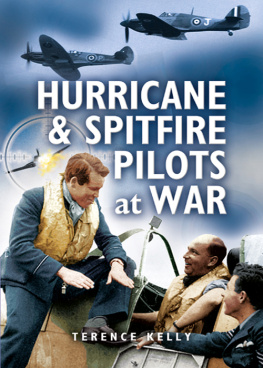SYDNEY CAMM
HURRICANE AND HARRIER DESIGNER
Saviour of Britain
First published in Great Britain in 2019 by
Air World
An imprint of
Pen & Sword Books Ltd
Yorkshire Philadelphia
Copyright John Sweetman, 2019
ISBN 978 1 52675 622 0
eISBN 978 1 52675 623 7
Mobi ISBN 978 1 52675 624 4
The right of John Sweetman to be identified as Author of this work has been asserted by him in accordance with the Copyright, Designs and Patents Act 1988.
A CIP catalogue record for this book is available from the British Library.
All rights reserved. No part of this book may be reproduced or transmitted in any form or by any means, electronic or mechanical including photocopying, recording or by any information storage and retrieval system, without permission from the Publisher in writing.
Pen & Sword Books Limited incorporates the imprints of Atlas, Archaeology, Aviation, Discovery, Family History, Fiction, History, Maritime, Military, Military Classics, Politics, Select, Transport, True Crime, Air World, Frontline Publishing, Leo Cooper, Remember When, Seaforth Publishing, The Praetorian Press, Wharncliffe Local History, Wharncliffe Transport, Wharncliffe True Crime and White Owl.
For a complete list of Pen & Sword titles please contact
PEN & SWORD BOOKS LIMITED
47 Church Street, Barnsley, South Yorkshire, S70 2AS, England
E-mail:
Website: www.pen-and-sword.co.uk
Or
PEN AND SWORD BOOKS
1950 Lawrence Rd, Havertown, PA 19083, USA
E-mail:
Website: www.penandswordbooks.com
Preface
Sydney Camm declared the Hawker Hart biplane, which as well as its several derivatives including the Hind, Audax and Demon flew with a substantial number of Royal Air Force squadrons before the Second World War, one of his favourite designs. In the United Kingdom though, he is best remembered for the Hurricane, and in the United States for the revolutionary Harrier jump jet.
The pivotal performance of the Hurricane during the Battle of Britain created a sensational headline in the News Chronicle : This Man Saved Britain, with a photo of Camm beneath. Similarly, the Minister of Economic Warfare, Lord Selborne, advised Winston Churchill that to Camm England owed a great deal.
In the USA, awarding Camm the prestigious Daniel Guggenheim medal, Grover Loening pointed out that Sydney Camm had designed fifty-two types of aircraft. After praising the conspicuously outstanding Hurricane, and its designer as a great aeronautical engineer whose work has benefited all of us, he focused on the Harrier: In this plane is achieved at last the perfection of an air vehicle. Independently, Dr William D. Siuru, Colonel USAF (Ret), noted: Some sixty different V/STOL designs had previously unsuccessfully sought to unite vertical and horizontal flight, in the USA, Soviet Union, France, Germany and by other British firms.
Without doubt, when Camm was its Director of Design, Hawker Siddeley did initiate the first viable jump jet. However, through NATO, American finance had been essential in the concepts infancy, so had technical assistance and personal encouragement from US officials engaged in a similar quest, which Camm freely acknowledged. At NASA, John Stack enthusiastically declared, we gotta get some greenbacks on this program. Camm also paid tribute to the invaluable assistance and support provided throughout his career by British firms and institutions like the Royal Aircraft Establishment, Rolls-Royce and the National Physical Laboratory, as well as the crucial contribution of Dr Stanley Hooker at Bristol Aero Engines. Nor did he overlook the critical work of Hawkers staff, especially his young gentlemen of the jet era. The detail design of the P.1127 prototype aircraft, which developed into the Harrier, was at root their achievement.
Obituaries of Camm in Britain were dominated by the Hurricane. The Sunday Express and The Sunday Times referred to him as the Hurricane Designer or Hurricane Maker, implying that this machine represented the pinnacle of Camms professional career. The Hurricane indisputably did have a direct influence on the survival of the country in 1940. However, like Loening, Sir Thomas Sopwith, the respected aircraft designer and Hawker aircraft company founder, believed that Camm deserved much wider recognition, being undoubtedly the greatest designer of fighter aircraft the world has ever known; in truth, a debatable assertion.
Sir Sydney Camms life and career were extraordinary, especially as he lacked the advantages of a financially-secure upbringing and formal technical education after leaving school at 14. Self-taught, he designed model aircraft and man-lifting gliders as a teenager and, in 1913, began work on an engine-driven aeroplane. In the decade before 1925, Camm advanced from apprentice carpenter to chief designer of H.G. Hawker Engineering Co Ltd, the firm controlled by Thomas Octave Murdoch Sopwith with which Camm would remain through its various changes of name for the rest of his life. When he became chief designer, the firms order book was threadbare. Within ten years, Hawkers was providing over eighty per cent of the RAFs operational aircraft, and overseas sales were flourishing. His vast array of biplanes and monoplanes, piston-engine and jet machines, bombers and fighters, would be flown by air forces quite literally throughout the world.
The eldest of twelve children, eleven surviving infancy, born and raised in a small, terraced house, Camm would be knighted in his own country, receive formal honours in France and the United States, and be inducted to the International Air and Space Hall of Fame in San Diego. From his early days at Hawkers, he showed the ability to gain and retain the confidence of powerful figures like Sopwith, as well as permanent Air Ministry staff who would remain in office during and after the Second World War. Post-1945, as Sopwith exercised less direct contact with Whitehall, Camm enjoyed personal access to the heads of the armed forces and government ministers.
Beyond the drawing board, he made a positive contribution to wider aspects of aeronautical progress, through thoughtful and innovative articles, as well as informative talks on the radio and television. In 1919, aged 26, Camm published Aeroplane Construction , which attracted international attention. It contained a comprehensive analysis of aeronautical practice and aerial potential, and was enthusiastically reviewed in the USA and Britain. In 1920 and 1921, he composed lengthy articles for The Manchester Guardian on the future of military and civilian aviation. Until shortly before his death, he continued to pen pieces for publication in the press and professional journals, as well as giving interviews to journalists and aviation specialists about aspects of design and construction.


